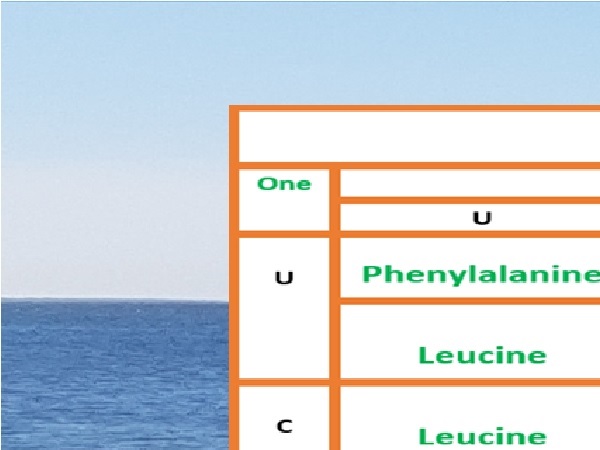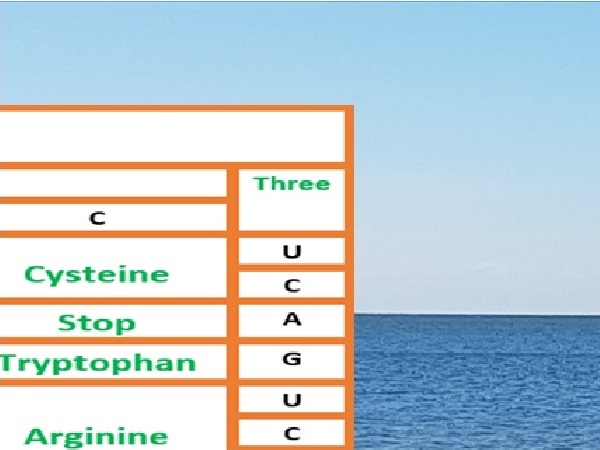The Sights

When destiny calls: Make the personal commitment.
Some content from page 24 sets the starting context for this page. Enjoy.
The electronic version of our book can be purchased from the Kindle store.
Check out our videos on YouTube. First video. And Second video.
Page 24 context
Where did we finish? Ah yes. Enjoy.
Remember now, sonnets are meant to be spoken.
Henri
The above table is in the front of each of our first three books. We think it gets the heart pumping on the mysteries of biology. Its language, programming, signalling, sensors, set-points, machines, etc. We put it in as a goal. Even though the picture was fuzzy on what it meant, we put it in for focus. And one day some details may be clearer. Our topic now is biology, so the table can take front and center.
The table is the list of amino-acids that make up the thousands of proteins in the body, when the genetic code is taken three letters at a time (ah la, codons) and using the four-letter alphabet.
For exercise: Hit the books (Or, The Book).
This is our continuing project: The search for happiness, destiny and how to rescue souls. "CTU IV: Destiny calls". Enjoy.
Some of the following content will have a deeper context after reading Contemplate the Universe, Beyond the veil and The Touch.
Henri
Have a go a searching on "methylation". It gives a glimpse into the epigenetic functions in the body. These are functions that are not initiated by the DNA, but by other factors already existing in the cell.
The central dogma: DNA - amino-acids - proteins - function, is associated with Darwin's theory of natural selection with mutations added in the mix. (ah la, life revolves around DNA)
Epigenetic mechanisms explode that theory, where external and internal factors for the cell and body plans rely on pre-existent body plans and systems to access and alter how DNA is expressed in the cell or the body plan. So with epigenetics, DNA becomes a support player.
This is a positive for skeptics of evolution because this process shows that organisms can adapt quickly to the new conditions that life presents. Life doesn't evolve it adapts, and new species and varieties arrive because of built-in potential. We can hear the boos and hisses now. Never mind.
Henri
A little bit more reading on methylation reveals that the protein that tags the DNA has to be 'charged' with the 'methyl?' molecule. Sort of, akin to tRNA being "charged" by picking up an amino-acid, somehow. I think the protein that does that, has a technical name that not even a three letter acronym, TLA, will cover.
Imagine the process: All systems must be in place, sensors and transducers for detecting additional requirements, signalling to prompt the tagging protein into action, goes somewhere to charge, heads into the nucleus to tag the DNA and so forth. Fascinating, and not even the technical details there. Beyond our technology.
Henri
Have a go at thinking about what happens when we go to the gym more often, or if the job we are doing becomes a bit more arduous. And let's link it to bird beak size.
Is there any doubt that we can change the shape of our bodies by the work we do, either for fun or work? That, by any stretch of the imagination, is not evolution. Beaks changing because of different environments and food and having to work harder, so beaks change, is not evolution either.
Additional to this, there is enough information out there now, to show that changes to organisms, initiated by the environment, can be passed onto the next generation. That's the opposite of evolution.
Think about the process: Sensors to pick up the extra stress on the organism, signalling to tag DNA, altering amino-acid sequencing to alter proteins or increase production, etc. Factory settings and the production lines. Oh contemplate.
Henri
What's the difference between a sensor and a transducer, for an interested amateur? A sensor detects something physical out there, like temperature, pressure, light, movement, etc. A transducer takes what the sensor detects and changes that into something, like an electrical current or voltage, which can be useful to control something.
Sometimes a detector can produce a voltage. An example of this is a thermocouple, which is two different metals joined together. When heated, the thermocouple produces a tiny voltage. To be useful, that voltage should be boosted by some electronics to feed into a control system. That bit of electronics could be called an interface.
So a transducer could be viewed as the interface between the detector and the control system. Let's apply that to a Cornelius post. He has a description on 'prestin'. I can't remember when. Prestin is "a transmembrane protein found in the outer hair cells of the cochlea" of our ears. The movement of the hair creates an electrical signal that heads off into the brain somewhere.
Short version: The hair movement is the sensor. That movement creates all sorts of electrical activity via the cell wall, etc, and that's the transducer part.
In our electronics, we can change a non-linear input to linear output or other way around. It appears that activity associated with the movement of the hair can do the same. Small movements: More activity; Large movements: Less activity. And a boosted signal. Wow!
Remember, all the stuff associated with hearing depends on a logarithmic scale: Decibels, etc. So the stuff associated with prestin is very closely linked to instrumentation 101. All the thrills.
Henri
I've just found a recent Cornelius post on 'prestin'. Written April 10th 2017, at his 'Darwin's God', blog site. He links the findings with ears to echo location in bats and whales. A very informative post.
Henri
The following thought bubble is a rewrite of the first sonnet I ever wrote. Yes, it was on origins. It looks like I've decided to rewrite my first set of eight sonnets I wrote in 2001.
Henri
The above thought bubble was written after I watched part of a Michael Mosley food show on our ABC, focusing on taste buds, and his evolution insights.
I remember thinking, evolution spin in a food show, then Brian Cox with his star gazing show, evolution spin, and then David Attenborough, with his shows on every channel, all evolution. Wall to wall evolution.
Oh well. Henri
Contact us
The electronic version of "Contemplate the Universe" can be purchased from the Kindle store. For some context on associated books, search on "Intelligent design".
Say G'Day: henri@ctubybp.com.au






